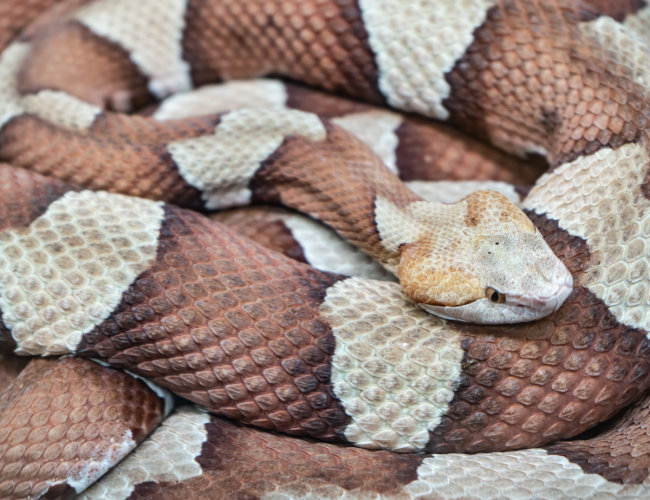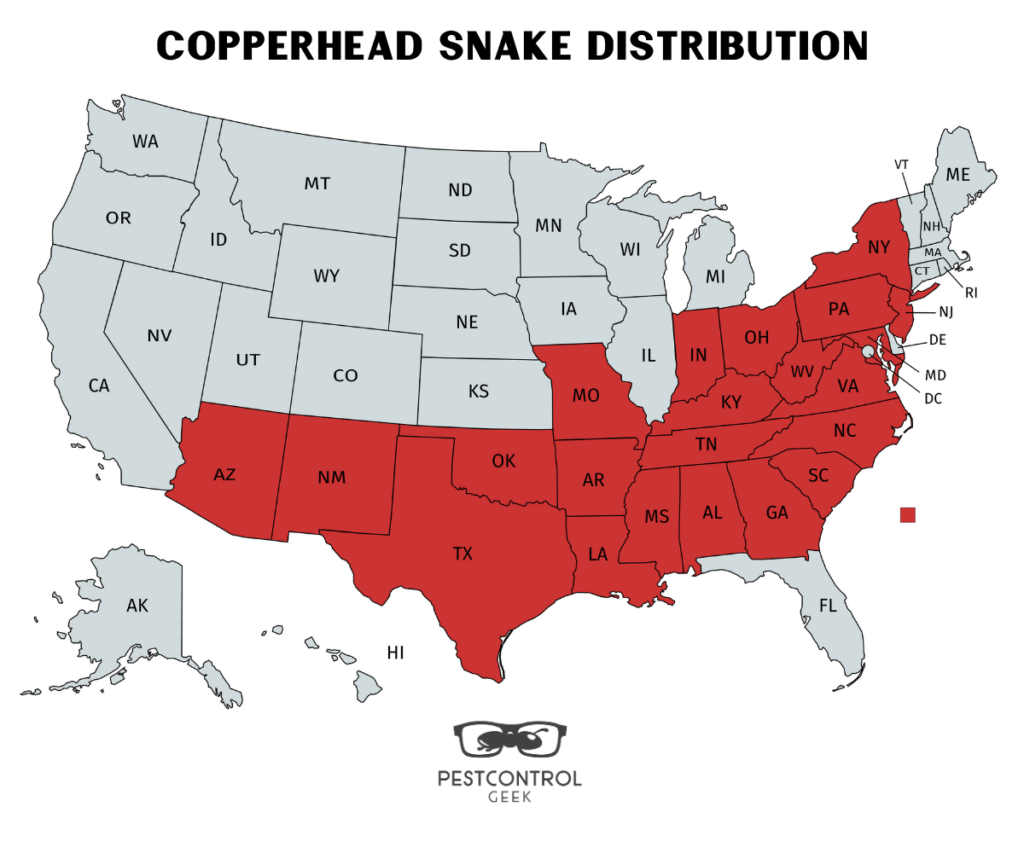Are you worried about snakes in your yard? I understand how you feel; not only are snakes disgusting, but they are dangerous.
Don’t worry any longer.
In this post, I will go over copperhead snake basics and how to get rid of them.
Let’s get started.
What Do Copperhead Snakes Look Like?

Copperhead snakes get their name for their signature copper-red color. But there are some key characteristics to look for if you think you have a copperhead snake.
- Color: color varies from light brown to chestnut-copper reds.
- Pattern: Distinct hourglass-shaped pattern, stretching from one side to the other side of the snake
- Bands are sometimes irregular and do not match.
- Eye: Yellow eye with a black vertical and elliptical pupil
- Size: 24 – 40 inches
- Head Shape: triangular, distinct arrowhead shape
Where Do Copperhead Snakes Live?

Copperhead snakes are common from New England to the Northern regions of Mexico. They are common in the coastal states except for Florida.
These snakes are quite adaptable and adjust to their habits, depending on where they are living.
If you are in a state where copperheads are present, you can narrow the local regions by looking at state websites. Most state websites include warnings of where these snakes are most common.
Where Do Copperhead Snakes Hide?
Copperhead snakes are adaptable snakes that don’t hide or live in the same places. Depending on the specific environment they are living in, they will live and hide in different areas. They commonly hide under any object they fit under.
Some common places copperheads snakes tend to prefer to nest include:
- Wooded or forest areas
- Rocky wooded areas
- Near Streams
- Deserts
- Canyons
While they are adaptable, they prefer areas where there is plenty of sunlight and protection coverage.
How To Get Rid of Copperhead Snakes?
1. Snake Traps
Traps are the standard technique for getting rid of most pests inside and around your home. Setting snake traps is excellent for tackling smaller infestations or one of occurrence.
For larger infestations, traps may not be as effective. To be effective, you would need to use extensive traps around your home. While this method can get rid of snakes, to keep them away, you would need to keep traps active for extensive periods.
There are several different types of traps you can use to catch snakes.
Humane Traps
Humane traps are designed to keep snakes alive and not cause any harm. Other traps can kill or harm snakes.
These traps have a simple design that allows snakes to enter, but they can’t exist. Once the snakes enter the trap, you can release them safely or hand them over to a pest control agency.
To get snakes inside your traps, you want to use some form of bait. Live bait is the most effective but not always easy to get a hold of.
If you are using live bait, I recommend:
Glue Traps
Glue traps are the easiest and most effective traps you can use on snakes. They are easy to place and inexpensive.
Place these anywhere you suspect snakes. If you are placing these traps outdoors, be sure to use the box covers. These boxes protect the glue traps and keep them sticky for longer.
Also, snakes like hiding in dark, secure places, and the entrances to the boxes provide that.
Like live traps, you can include bait on the glue trap to entice snakes to enter the traps.
2. Use Snake Repelling Plants
Plants are used to repel many pests, including snakes. There are certain plants that snakes can’t stand. If you position these around your property, this is a great way to drive snakes away from your home.
When using plants to repel snakes, you must recognize the limited range. For example, one lemongrass plant will not protect a 10,000 square foot property.
Plants are only useful within the range that you can small them. Depending on the plant, this can range from 2-5 feet to nearly 10 feet in either direction.
An excellent way to measure a plant’s range is to stand in front of the plant and walk away until the scent is no longer present. This is the range where these plants are effective.
Some of the most effective plants that repel snakes include:
- Lemon Grass
- Marigold
- Dracaena Trifasciata or Mother-in-law’s tongue
- Garlic
These plants are known to be effective at repelling snakes from your yard.
3. Exclusion
The best way to get rid of snakes is truly exclusion. Keeping snakes outside of your yard is the most effective way to get rid of them.
In some states, snakes are apart of the ecosystem, so removing them completely is impossible. This is especially true if you live near wooded or desert areas.
The most effective way to keep copperheads snakes off your property is to use a snake fence.
Snake fences are a thin metal mesh fence that is applied around your entire property. These will prevent snakes from entering your property.
For the most effective use snake fence, you want to use a metal mesh with gaps that are no larger than ½ inch and at least 36 inches high.
Copperheads snakes will not reach smaller than ½ inch due to their unique head shape. Likewise, copperheads snakes can only stand about half their height.
At a max length of 40 inches, they can only stand around 20 to 24 inches. To be 100% sure that snakes don’t enter your home, the ideal height is about 36 inches but no shorter than 24 inches.
The great thing about snake fences is that you can apply them to your current fences.
4. Eliminate Water and Food Sources
One way to get rid of snakes is to make the area around your home as unappealing as possible.
The way you can do this is to eliminate any water or food sources from your home.
If snakes can’t survive, they will seek other locations to live.
Eliminate Food Sources
The best way to make your home as unappealing as possible is to ensure no food sources are nearby. The fewer food sources available, the less likely copperhead snakes are to live around your home.
Copperhead snakes eat various insects and animals, which means to keep snakes away, you need to proactive with eliminating various pests around your home.
Some common food sources include rodents and insects around the area. They also tend to eat certain mammals and reptiles.
Some animals that snakes eat include:
